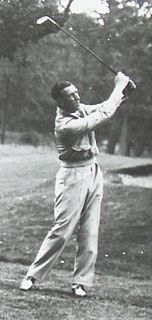The Irish Open is a professional golf tournament on the European Tour. Since 2015, the Irish Open has been hosted by Rory McIlroy, and his charitable foundation is the main benefactor; the title sponsor is Dubai Duty Free.

Alfred Harry Padgham was one of the leading British professional golfers of the 1930s and 1940s.
James Adams was a Scottish professional golfer who was chosen for five Ryder Cup sides and achieved high finishes in The Open Championship on several occasions.
Charles Albert Whitcombe was an English golfer. He was born in Berrow, Burnham-on-Sea, Somerset, the second of the three Whitcombe brothers who were all successful English professional golfers in the 1920s and 1930s and – despite never winning The Open Championship like his younger brother Reg – could be considered the most prominent of the three, winning the British PGA Matchplay Championship twice and captaining the Ryder Cup side four times.
Allan Marshall Dailey was a Scottish professional golfer. He won the Roehampton Invitation in 1933 and was subsequently selected for the 1933 Ryder Cup but didn't play in any matches. He finished in a tie for 4th place in the 1938 Open Championship. He was from a golfing family. His father James Russell Dailey was a professional golfer as was his brother Russell.
The Dunlop-Metropolitan Tournament was an invitation professional golf tournament played in South East England. It was founded in 1934. The tournament was played towards the end of the season and was played over 72 holes of stroke play. The event had a small field; entry being mostly based on high finishes in important British and Continental events earlier in the year. Past Open Champions were also invited. The tournament was informally called "The Championship of Champions" and was "equivalent almost to the Masters' tournament of America" which was also founded in 1934.

The R.T.V. International Trophy was a professional golf tournament. In its first year, 1967, there was a professional team tournament between the four home nations at Edmondstown Golf Course, County Dublin. The next year the event became an individual tournament played at Cork Golf Club, Little Island, Cork, Ireland. The individual event was held twice, in 1968 and 1969. The tournaments were sponsored by R.T.V. Rentals.
The England–Scotland Professional Match was an annual men's professional golf competition between teams representing England and Scotland. It was played from 1903 to the start of World War I and was then revived in 1932 and played until the start of World War II. The match was played on a single day, generally a few days before the Open Championship. Except on one occasion, there were 12 players in each team who played 12 singles matches and 6 foursomes. Scotland won the inaugural match in 1903 but didn't win another match, although three matches were tied. The event was organised by the PGA and only members of the PGA were eligible to play.
The Ireland–Scotland Professional Match was an annual men's professional golf competition between teams representing Ireland and Scotland. It was played from 1932 to 1936. The match was played on a single day with 10 players in each team who played 5 foursomes and 10 singles matches. The first match in 1932 was tied but Ireland won the next four contests.
Albert Gadd was an English professional golfer. He won the French Open in 1933, the Irish Open in 1937 and twice finished in the top 10 in The Open Championship.
Ernest Edward Whitcombe was an English professional golfer. He was the son of Ernest Whitcombe and was always known as Eddie.
Donald Allen Curtis was an English professional golfer.
James Summers Forrester was a Scottish professional golfer. He won the Northern Open in 1934 and the Scottish Professional Championship in 1936. In 1937 he replaced Henry Cotton at Waterloo Golf Club in Belgium but died the following year in a Belgian hospital following complications after an operation for appendicitis.
Thomas Peter Dobson was a Scottish professional golfer. He won the Scottish Amateur in 1925. As a professional he represented Scotland on many occasions in the 1930s.





